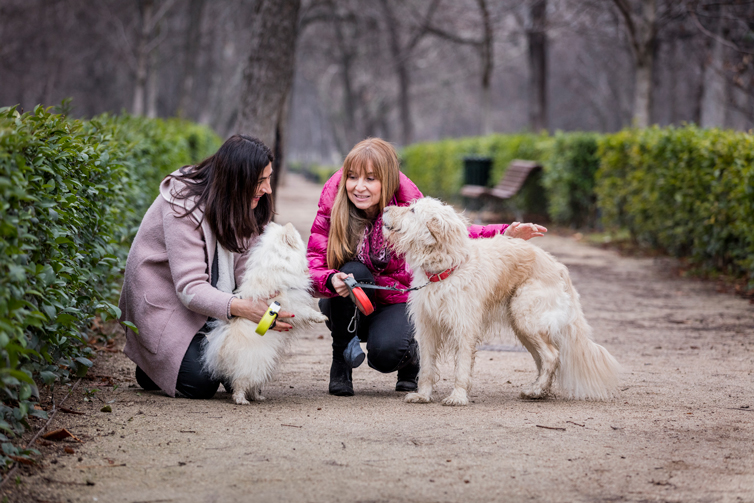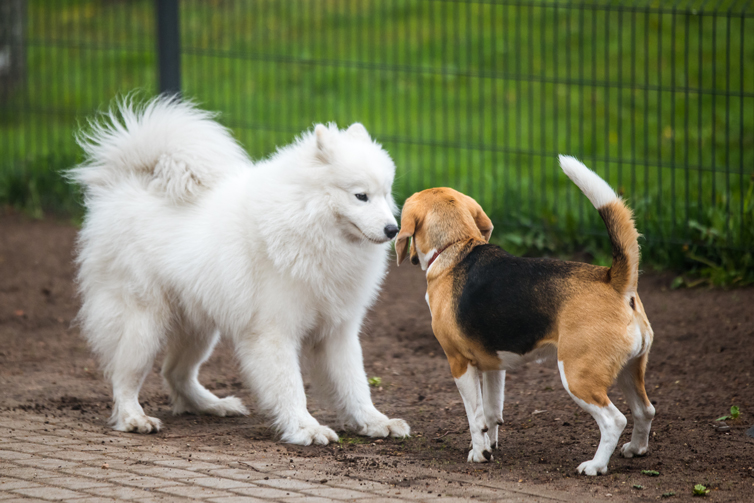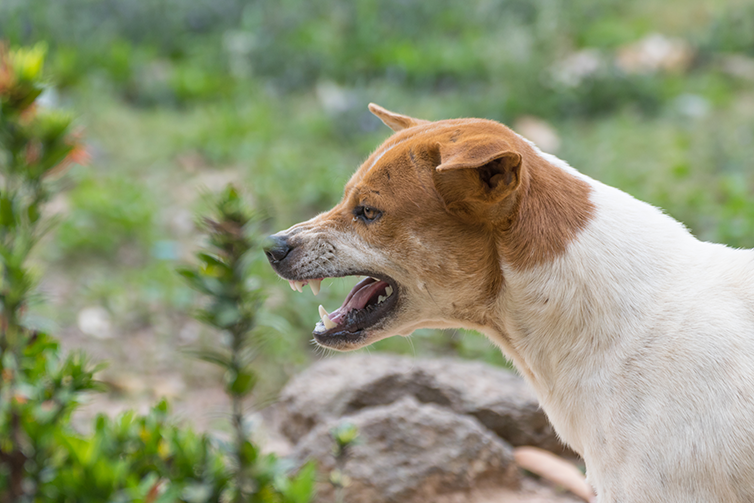Socialising Your Woofers

What does dog socialisation mean?
Nobody is particularly fond of persistently naughty children, especially when their behaviour disrupts everyone’s attempts to lead a relatively peaceful life, including their parents. You know, the kind of kids who cannot be taken anywhere because they wreck their surroundings, are rude to adults and to each other and constantly demand attention. Well, the same can be said for ‘naughty’ dogs, can’t it? People don’t like them – except perhaps for doting (human) mommy – and other dogs don’t like them either. In both cases, children and furry friends, they need to be taught, from an early age, what is acceptable behaviour in various situations and what is not. They need to be familiarized with as many different environments and situations as possible, so that they will realise what is threatening and what is not, and will learn to act accordingly. Someone creeping around your garden in the middle of the night may be threatening; granny arriving for lunch is not. (Well, depending on the granny, we suppose.)
At what age should socialization start?

Puppies will be taught some basic socialization skills by their mothers, but most skills will need to be taught by people. Many puppies are picked up from the breeder, or rescue centre, at around 8 weeks of age, but they can’t socialize until after their 2nd vaccinations at about 9 – 10 weeks. The ‘sensitive period’, or ideal time, for learning social skills is before 16 weeks. So you only have 4 weeks, in theory, to ensure that your little home-wrecking Puppyzilla, becomes relatively civilized. In reality, however, you can begin this vital process as soon as your 8-week-old bundle of fluff comes home. Up until 16 weeks, puppy and you will find it relatively easy to learn/teach about new situations, people, objects, other dogs and pets, sounds, machines, and so on. After 16 weeks, they may have become more wary of new things and it may become increasingly difficult to get used to them.
But where do I start?
The following stages, based on the age of your puppy, are suggested (medivet.co.uk):
8 – 9 weeks
Get tiny furry used to being picked up and used to the members of your family and your other pets (Please ensure that all are vaccinated.), to household noises and machines, the doorbell and any visitors.
10 – 11 weeks
Introduce other items in and around your home, such as children’s toys and sports’ equipment. The vet should be introduced, necessitating a car trip. A harness (but please, not a collar, especially at this young age, as it can cause choking) and a lead could be worn for short periods, indoors.
12 – 14 weeks
Now, after their 2nd vaccination, they can venture outside with you, beginning, of course, with the garden. You may have a safe, enclosed garden, in which case, they may have been out, under supervision, already. There’ll be lots of new sights, sounds, smells, tastes (Be careful!) and ‘feels’ to explore.
It may be time to go beyond the garden gates, on a lead, even if this involves lots of pulling, twisting and tripping. (We’re talking about the pup here, not you.) People, often with other dogs, may approach. Gauge the situation carefully to avoid disaster. If you see a person approaching with a dog, bend down and chat to your pup. They will learn that they must engage with you before they engage with any dog. A small treat will reward good behaviour.
15 – 16 weeks
By now, puppy will probably have experienced most aspects of your daily life and the people and objects associated with it. Exposure should be increased, but take it slowly and calmly. A car hooter may mean nothing to us, but to young, delicate ears, it may be deafening and frightening. Fear is exactly what you want to avoid.
Some Golden Rules
- Try to act as normally and calmly as possible. Pups will be calm if you are. If you sense your poochie is worried or might panic, get down to his/her level and speak in a calm, reassuring way.
- Puppy, and you, may need an ‘escape route’ if you feel a situation may develop into a frightening one. For example, you may venture onto a road which turns out to be busy. Be prepared to pick up your pup and retreat. You will become attuned to signs of his/her fear and stress.
- Reward your pup when he/she does something ‘right’ and ignore it when he/she does something ‘wrong’. No animal ever learnt anything from being punished, in any way.
- Puppies may need to perform certain behaviours many times before they get it right. Be patient. They will learn nothing if you get agitated and frustrated.
- Make it fun! Fun, fun, fun! If it’s fun for you it’ll be fun for him/her and will be less likely to become boring or tedious.
- And … training doesn’t stop at 16 weeks. Keep going. You’ll both benefit.
What benefits come from puppy socialization?

Well, basically and simply, your pup, you and your family will be happier and more contented. Pup will feel more secure and confident. There will be fewer behavioural problems and less aggression in stressful situations. You will enjoy your puppy far more as there will be fewer confrontations both with you and with other people and dogs. You will be able to take him/her out on more walks, trips and holidays, without the nerve-wracking experience of constantly worrying about whether he/she might at any minute, become Pupzilla and disgrace you. And remember that it’s much easier to socialise a small pup than a mature dog.
Will puppy socialization classes help?
Usually, yes, especially if you are working during the week and if you can find a weekend class. They are a good way for your pup to meet other dogs, and people. Basic obedience training may be offered, although this usually takes quite a long time. Classes are generally run by an animal behaviourist who will help you, and pup, to deal with various problems as they come up. Ensure that your ball of fluff is vaccinated.
Can older dogs be socialized?
Absolutely. In an ideal world, all dogs would be socialized in their first weeks, during the critical ‘imprint’ period (before 16 weeks), or at least in their first year. But sometimes this is not possible, for various reasons. For example you may adopt an older dog, perhaps from a rescue centre. During the Covid pandemic, many families adopted puppies, but lockdowns meant that it would be difficult to socialize these fur-balls. However, with time and patience, older dogs can be effectively socialized.
What sort of problems can be caused as a result of no socialization?
Older dogs who have not been socialized as puppies may become anxious, fearful or aggressive. They may be afraid of strange people or other dogs. You may battle with them at the doggie parlour and the vet. All of these traits will make life difficult for you and for your poochie.
Have you got some tips for training an unsocialised, mature dog?

- Let your dog set the pace: Don’t rush or force it. If you do, you may increase your dog’s anxiety.
- When training, keep a reasonable or ‘safe’ distance from possible stressful situations, like strange dogs or people, especially at first.
- Praise and reward desired behaviour and ignore bad. This is the key. Never shout and never punish. You will make your doggie anxious and afraid and impossible to train. Delicious doggie treats will be very helpful here. Pair the potential stressor or trigger with a reward. For example, you are about to encounter another dog on a walk: give treats; a visit to the vet: give treats.
- Be realistic. Your mature furry friend will not be able to learn as quickly as a pup. That’s not his/her fault, and in most cases, it’s not your fault either. Some dogs are naturally Furry Angels: they are compliant, sociable and love everybody, by nature. Most dogs are not like this, so you need to decide on realistic expectations. Some of these might be, for example, being able to play with a couple of doggie friends; behaving themselves at the vet and pooch parlour; going for walks without barking at other dogs and people; coping with loud noises, such as fireworks.
- Start small. For example, walking on a lead in a ‘civilised’ manner. Then you can work on these abilities: encountering other dogs and people on a walk; dealing with car hooters, and so on. Remember: Reward! Reward! Reward! Your poochie, and you, will gradually find that you enjoy this training.
- Be patient and be calm. A steady and slow pace works best. Gradually, the stressor or trigger will become more acceptable. For example, the distance that your pooch will ‘allow’, without panicking, between him/her and the trigger can be gradually reduced. Remember: baby steps.
- Watch for signs of stress, such as licking of lips and paw lifting. These signs indicate that you should ‘cool it’ and move away from the potentially stressful situation.
- Try to discover your furry friend’s ‘threshold’. Some anxiety when facing stressors is natural and normal, but too much anxiety will prevent your pooch from learning. There are signs to watch out for which suggest that you’ve gone over this threshold:
Not interested in treats
Physically frozen
Snapping at the air
Attempting to run away
Barking or growling
Any of these suggest that you should stop and retreat. Poochie has ‘had it’, possibly for the day.
- Avoid overwhelming situations, such as crowds and lots of dogs, at least in the initial stages of training. Your doggie may become frightened and overwhelmed and will not be able to concentrate on learning.
- Don’t give up! Training an older dog takes a lot of time. ‘Old habits die hard’.
- Consult a professional. This could take the form of socialization classes for older dogs or consulting an animal behaviourist. Only work with trainers who use the ‘positive reinforcement’ or rewards-based approach. Your vet will also be able to advise you.
What about visits to a doggie park?
Doggie parks can be great for socialized dogs. They give them a wonderful opportunity to run around and sniff freely. Some parks insist on leads, others allow dogs to run free. Whatever the ‘rules’ of the park, you would be very foolish to allow an unsocialised dog to be off the lead. There are, unfortunately, those people who may not be conscientious about this.
- Do not assume that all dogs who are running free are socialized. You are responsible for your dog’s safety – a dog fight is a horrifying thing.
- Keep an eye on your doggie at all times.
- As a service to everyone using the park, don’t forget your pooper-scooper, or at least a supply of plastic bags.
- Also, make sure your poochie is fully vaccinated and that female dogs in heat are left at home.
- Before allowing your dog to play with another strange dog, speak to the owner to find out if this will be safe; they should both be kept on leads, at least initially.
- Don’t bring small puppies to a dog park. It will be overwhelming and is not safe for a little fur-ball.
And finally…
Remember to have fun: both you and your furry friend! The very best learning, for animals and humans, takes place in a non-threatening, relaxed atmosphere. Don’t look on training as a tedious job to be ‘got through’, but as a wonderful chance for you and your doggie to enjoy yourselves and, most important of all, to bond.
ZA-BRV-220500005
Subscribe to our Newsletter
Get to know your furry friend better! Sign up for all things dog- or cat-related.
The Hairy Facts about the dreaded hairball
12 April 2021
Help! My dog’s barking mad! Volume 2
12 April 2021
Your Itchy, Scratchy Cat – All About Cat Skin Problems
12 April 2021
The Dog’s Diet: A Bone of contention?
01 April 2021
Mango Fly Worms: How to Spot and Eliminate them
Posted on November 28,2019
Managing Mange And Mites In Your Dog
Posted on June 11,2018
Why Do Cats Purr and How? Learn What Your Cat Is Saying
Posted on October 14,2020
How to Get Rid of Ear Mites in Dogs
Posted on November 06,2019









